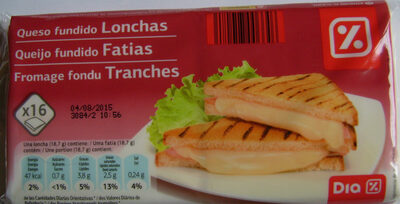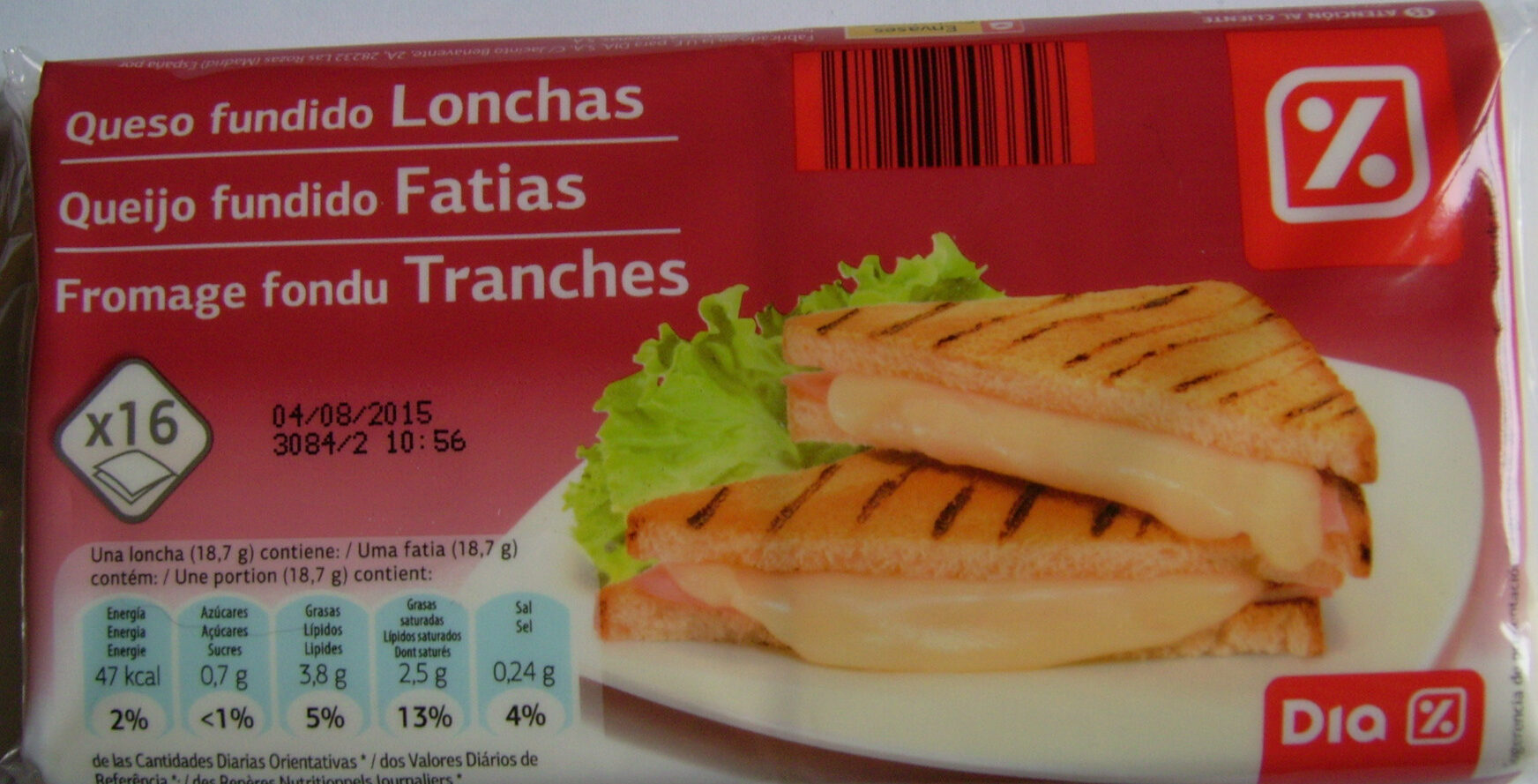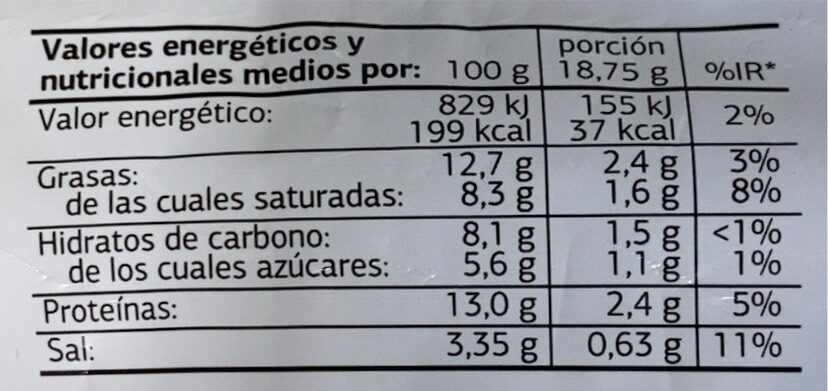Help us make food transparency the norm!
As a non-profit organization, we depend on your donations to continue informing consumers around the world about what they eat.
The food revolution starts with you!
Fromage fondu tranches - Dia - 300 g
Fromage fondu tranches - Dia - 300 g
This product page is not complete. You can help to complete it by editing it and adding more data from the photos we have, or by taking more photos using the app for Android or iPhone/iPad. Thank you!
×
Barra-kodea: 8480017006646 (EAN / EAN-13)
Izen arrunta: Fromage fondu tranches
Kopurua: 300 g
Ontziratzea: fr:Sachet plastique, fr:Sachet plastique individuel
Markak: Dia
Kategoriak: Esneki, en:Fermented foods, en:Fermented milk products, Gazta, en:Sliced cheeses, en:Melted cheese
Etiketak, ziurtagiriak, sariak:
en:No gluten, en:Green Dot
Origin of ingredients: Espainia
Traceability code: ES 15.359/O C CE
Dendak: Dia
Matching with your preferences
Health
Osagaiak
-
18 ingredients
Frantses: Lait concentré écrémé, fromage, beurre, protéines de lait, amidon modifié, sel de fonte (E-452i, E-339ii, E-339iii, E-450i, E-331iii), sel, épaississants (E-407, E-415, E-508) et conservateur (E-200)Alergenoak: en:Milk
Food processing
-
Ultra processed foods
Elements that indicate the product is in the 4 - Ultra prozesatutako elikagaiak eta edariak group:
- Gehigarria: E14XX
- Gehigarria: E407
- Gehigarria: E415
- Gehigarria: E450
- Gehigarria: E452
- Osagaia: Milk proteins
- Osagaia: Thickener
Food products are classified into 4 groups according to their degree of processing:
- Prozesatu gabeko edo ahalik eta gutxien prozesatutako elikagaiak
- Sukaldaritzako osagaiak prozesatu
- Prozesatutako jakiak
- Ultra processed foods
The determination of the group is based on the category of the product and on the ingredients it contains.
Gehigarriak
-
E200
Sorbic acid: Sorbic acid, or 2‚4-hexadienoic acid, is a natural organic compound used as a food preservative. It has the chemical formula CH3-CH-4CO2H. It is a colourless solid that is slightly soluble in water and sublimes readily. It was first isolated from the unripe berries of the Sorbus aucuparia -rowan tree-, hence its name.Source: Wikipedia (Ingeles)
-
E331
Sodium citrate: Sodium citrate may refer to any of the sodium salts of citrate -though most commonly the third-: Monosodium citrate Disodium citrate Trisodium citrateThe three forms of the salt are collectively known by the E number E331. Sodium citrates are used as acidity regulators in food and drinks, and also as emulsifiers for oils. They enable cheeses to melt without becoming greasy.Source: Wikipedia (Ingeles)
-
E331iii
Sodium citrate: Sodium citrate may refer to any of the sodium salts of citrate -though most commonly the third-: Monosodium citrate Disodium citrate Trisodium citrateThe three forms of the salt are collectively known by the E number E331. Sodium citrates are used as acidity regulators in food and drinks, and also as emulsifiers for oils. They enable cheeses to melt without becoming greasy.Source: Wikipedia (Ingeles)
-
E339
Sodium phosphates: Sodium phosphate is a generic term for a variety of salts of sodium -Na+- and phosphate -PO43−-. Phosphate also forms families or condensed anions including di-, tri-, tetra-, and polyphosphates. Most of these salts are known in both anhydrous -water-free- and hydrated forms. The hydrates are more common than the anhydrous forms.Source: Wikipedia (Ingeles)
-
E339ii
Sodium phosphates: Sodium phosphate is a generic term for a variety of salts of sodium -Na+- and phosphate -PO43−-. Phosphate also forms families or condensed anions including di-, tri-, tetra-, and polyphosphates. Most of these salts are known in both anhydrous -water-free- and hydrated forms. The hydrates are more common than the anhydrous forms.Source: Wikipedia (Ingeles)
-
E339iii
Sodium phosphates: Sodium phosphate is a generic term for a variety of salts of sodium -Na+- and phosphate -PO43−-. Phosphate also forms families or condensed anions including di-, tri-, tetra-, and polyphosphates. Most of these salts are known in both anhydrous -water-free- and hydrated forms. The hydrates are more common than the anhydrous forms.Source: Wikipedia (Ingeles)
-
E407
Carrageenan: Carrageenans or carrageenins - karr-ə-gee-nənz, from Irish carraigín, "little rock"- are a family of linear sulfated polysaccharides that are extracted from red edible seaweeds. They are widely used in the food industry, for their gelling, thickening, and stabilizing properties. Their main application is in dairy and meat products, due to their strong binding to food proteins. There are three main varieties of carrageenan, which differ in their degree of sulfation. Kappa-carrageenan has one sulfate group per disaccharide, iota-carrageenan has two, and lambda-carrageenan has three. Gelatinous extracts of the Chondrus crispus -Irish moss- seaweed have been used as food additives since approximately the fifteenth century. Carrageenan is a vegetarian and vegan alternative to gelatin in some applications or may be used to replace gelatin in confectionery.Source: Wikipedia (Ingeles)
-
E415
Xanthan gum: Xanthan gum -- is a polysaccharide with many industrial uses, including as a common food additive. It is an effective thickening agent and stabilizer to prevent ingredients from separating. It can be produced from simple sugars using a fermentation process, and derives its name from the species of bacteria used, Xanthomonas campestris.Source: Wikipedia (Ingeles)
-
E508
Potassium chloride: Potassium chloride -KCl- is a metal halide salt composed of potassium and chlorine. It is odorless and has a white or colorless vitreous crystal appearance. The solid dissolves readily in water and its solutions have a salt-like taste. KCl is used as a fertilizer, in medicine, in scientific applications, and in food processing. In a few states of the United States it is used to cause cardiac arrest as the third drug in the "three drug cocktail" for executions by lethal injection. It occurs naturally as the mineral sylvite, and in combination with sodium chloride as sylvinite.The version for injection is on the World Health Organization's List of Essential Medicines, the most important medications needed in a basic health system.Source: Wikipedia (Ingeles)
Ingredients analysis
-
en:Palm oil free
No ingredients containing palm oil detected
-
en:Non-vegan
Non-vegan ingredients: en:Condensed skimmed milk, Gazta, Gurin, en:Milk proteins
-
en:Vegetarian status unknown
Unrecognized ingredients: E339ii
-
Details of the analysis of the ingredients
fr: Lait concentré écrémé, fromage, beurre, protéines de lait, amidon modifié, sel de fonte (e452i, e339ii, e339iii, e450i, e331iii), sel, épaississants (e407, e415, e508), conservateur (e200)- Lait concentré écrémé -> en:condensed-skimmed-milk - vegan: no - vegetarian: yes - ciqual_proxy_food_code: 19051 - percent_min: 11.1111111111111 - percent_max: 100
- fromage -> en:cheese - vegan: no - vegetarian: maybe - ciqual_proxy_food_code: 12999 - percent_min: 0 - percent_max: 50
- beurre -> en:butter - vegan: no - vegetarian: yes - ciqual_proxy_food_code: 16400 - percent_min: 0 - percent_max: 33.3333333333333
- protéines de lait -> en:milk-proteins - vegan: no - vegetarian: yes - percent_min: 0 - percent_max: 25
- amidon modifié -> en:modified-starch - vegan: yes - vegetarian: yes - ciqual_proxy_food_code: 9510 - percent_min: 0 - percent_max: 20
- sel de fonte -> en:emulsifying-salts - percent_min: 0 - percent_max: 16.6666666666667
- e452i -> en:e452i - vegan: yes - vegetarian: yes - percent_min: 0 - percent_max: 16.6666666666667
- e339ii -> en:e339ii - percent_min: 0 - percent_max: 8.33333333333333
- e339iii -> en:e339iii - vegan: yes - vegetarian: yes - percent_min: 0 - percent_max: 5.55555555555556
- e450i -> en:e450i - vegan: yes - vegetarian: yes - percent_min: 0 - percent_max: 4.16666666666667
- e331iii -> en:e331iii - vegan: yes - vegetarian: yes - percent_min: 0 - percent_max: 3.33333333333333
- sel -> en:salt - vegan: yes - vegetarian: yes - ciqual_food_code: 11058 - percent_min: 0 - percent_max: 3.35
- épaississants -> en:thickener - percent_min: 0 - percent_max: 3.35
- e407 -> en:e407 - vegan: yes - vegetarian: yes - percent_min: 0 - percent_max: 3.35
- e415 -> en:e415 - vegan: yes - vegetarian: yes - percent_min: 0 - percent_max: 1.675
- e508 -> en:e508 - vegan: yes - vegetarian: yes - percent_min: 0 - percent_max: 1.11666666666667
- conservateur -> en:preservative - percent_min: 0 - percent_max: 3.35
- e200 -> en:e200 - vegan: yes - vegetarian: yes - percent_min: 0 - percent_max: 3.35
Elikadura
-
Poor nutritional quality
⚠ ️Warning: the amount of fruits, vegetables and nuts is not specified on the label, it was estimated from the list of ingredients: 0This product is not considered a beverage for the calculation of the Nutri-Score.
Positive points: 5
- Proteinak: 5 / 5 (balioa: 13, rounded value: 13)
- Fiber: 0 / 5 (balioa: 0, rounded value: 0)
- Fruits, vegetables, nuts, and colza/walnut/olive oils: 0 / 5 (balioa: 0, rounded value: 0)
Negative points: 21
- Energia: 2 / 10 (balioa: 833, rounded value: 833)
- Azukreak: 1 / 10 (balioa: 5.6, rounded value: 5.6)
- Gantz saturatua: 8 / 10 (balioa: 8.3, rounded value: 8.3)
- Sodioa: 10 / 10 (balioa: 1340, rounded value: 1340)
The points for proteins are counted because the product is in the cheeses category.
Nutritional score: (21 - 5)
Nutri-Score:
-
Nutrient levels
-
Koipe in moderate quantity (12.7%)
What you need to know- A high consumption of fat, especially saturated fats, can raise cholesterol, which increases the risk of heart diseases.
Recommendation: Limit the consumption of fat and saturated fat- Choose products with lower fat and saturated fat content.
-
Gantz-azido ase in high quantity (8.3%)
What you need to know- A high consumption of fat, especially saturated fats, can raise cholesterol, which increases the risk of heart diseases.
Recommendation: Limit the consumption of fat and saturated fat- Choose products with lower fat and saturated fat content.
-
Azukre in moderate quantity (5.6%)
What you need to know- A high consumption of sugar can cause weight gain and tooth decay. It also augments the risk of type 2 diabetes and cardio-vascular diseases.
Recommendation: Limit the consumption of sugar and sugary drinks- Sugary drinks (such as sodas, fruit beverages, and fruit juices and nectars) should be limited as much as possible (no more than 1 glass a day).
- Choose products with lower sugar content and reduce the consumption of products with added sugars.
-
Gatz arrunt in high quantity (3.35%)
What you need to know- A high consumption of salt (or sodium) can cause raised blood pressure, which can increase the risk of heart disease and stroke.
- Many people who have high blood pressure do not know it, as there are often no symptoms.
- Most people consume too much salt (on average 9 to 12 grams per day), around twice the recommended maximum level of intake.
Recommendation: Limit the consumption of salt and salted food- Reduce the quantity of salt used when cooking, and don't salt again at the table.
- Limit the consumption of salty snacks and choose products with lower salt content.
-
-
Nutrition facts
Nutrition facts As sold
for 100 g / 100 mlAs sold
per serving (1g)Compared to: en:Melted cheese Energia 833 kj
(199 kcal)8,33 kj
(1 kcal)-% 16 Koipe 12,7 g 0,127 g -% 26 Gantz-azido ase 8,3 g 0,083 g -% 27 Carbohydrates 8,1 g 0,081 g +% 52 Azukre 5,6 g 0,056 g +% 60 Fiber - - Proteina 13 g 0,13 g -% 12 Gatz arrunt 3,35 g 0,034 g +% 32 Fruits‚ vegetables‚ nuts and rapeseed‚ walnut and olive oils (estimate from ingredients list analysis) 0 % 0 %
Ingurumena
-
Eco-Score C - Moderate environmental impact
The Eco-Score is an experimental score that summarizes the environmental impacts of food products.→ The Eco-Score was initially developped for France and it is being extended to other European countries. The Eco-Score formula is subject to change as it is regularly improved to make it more precise and better suited to each country.Life cycle analysis
-
Average impact of products of the same category: C (Score: 47/100)
Kategoria: Processed cheese with fresh cream cheese and walnuts
Kategoria: Processed cheese with fresh cream cheese and walnuts
- PEF environmental score: 0.59 (the lower the score, the lower the impact)
- including impact on climate change: 5.44 kg CO2 eq/kg of product
Stage Impact Agriculture
81.7 %Processing
10.8 %Ontziratzea
2.7 %Transportation
2.9 %Distribution
1.5 %Consumption
0.4 %
Bonuses and maluses
-
Origins of ingredients with a low impact
Bonus: +18
Environmental policy: +3
Transportation: +15
Origin of the product and/or its ingredients % of ingredients Impact Espainia 100 %Baxua
-
Packaging with a medium impact
Malus: -10
Shape Material Recycling Impact Bag Plastic Altua
Eco-Score for this product
-
Impact for this product: C (Score: 55/100)
Produktua: Fromage fondu tranches - Dia - 300 g
Life cycle analysis score: 47
Sum of bonuses and maluses: +8
Final score: 55/100
-
Carbon footprint
-
Equal to driving 2.8 km in a petrol car
544 g CO² per 100g of product
The carbon emission figure comes from ADEME's Agribalyse database, for the category: Processed cheese with fresh cream cheese and walnuts (Source: ADEME Agribalyse Database)
Stage Impact Agriculture
83.4 %Processing
8.4 %Ontziratzea
3.4 %Transportation
4.0 %Distribution
0.7 %Consumption
0.1 %
Ontziratzea
-
Packaging with a medium impact
-
Packaging parts
Bag (Plastic)
-
Bilgarriaren materialak
Material % Bilgarriaren pisua Bilgarriaren pisua produktuaren 100g-ko Plastic
-
Transportation
-
Origins of ingredients
Origins of ingredients with a low impact
Origin of the product and/or its ingredients % of ingredients Impact Espainia 100 %Baxua
Report a problem
-
Incomplete or incorrect information?
Category, labels, ingredients, allergens, nutritional information, photos etc.
If the information does not match the information on the packaging, please complete or correct it. Open Food Facts is a collaborative database, and every contribution is useful for all.
Datuen iturria
Product added on by openfoodfacts-contributors
Last edit of product page on by thaialagata.
Produktuaren orria -gatik editatua chevalstar, ecoscore-impact-estimator, guezguez-majed, halal-app-chakib, hangy, inf, kiliweb, oc84, packbot, quechoisir, roboto-app, scanbot, tacite-mass-editor, yuka.WktZcUlvdFIrTXNPaWRzc3hBTE54TzU0NHBPRUFHeUhKOU16SUE9PQ, yuka.sY2b0xO6T85zoF3NwEKvlh0XTNT-gmnjJxDUkxPa9IagKMbra-gq-bHaLKg, yuka.sY2b0xO6T85zoF3NwEKvlkFcC-uPgTLrCCDVp3LXwMuJHKG2fclA4JnZYqs, yuka.sY2b0xO6T85zoF3NwEKvlkxOdf7vji3BDUzth3OE_f6JPLXTSsF2-qyibao, yuka.sY2b0xO6T85zoF3NwEKvlmFNVOvknDmVERnlv2PQ_sWzdo3ZcP9L3YfRKag, yuka.sY2b0xO6T85zoF3NwEKvlnROf4PArBCfFCzVm2Cs3PzVIca1YvJt77bGbqo.










